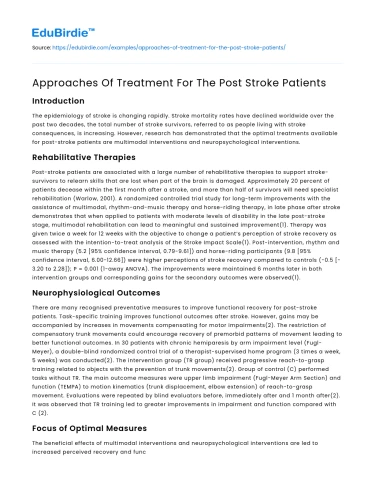Introduction
The epidemiology of stroke is changing rapidly. Stroke mortality rates have declined worldwide over the past two decades, the total number of stroke survivors, referred to as people living with stroke consequences, is increasing. However, research has demonstrated that the optimal treatments available for post-stroke patients are multimodal interventions and neuropsychological interventions.
Rehabilitative Therapies
Post-stroke patients are associated with a large number of rehabilitative therapies to support stroke-survivors to relearn skills that are lost when part of the brain is damaged. Approximately 20 percent of patients decease within the first month after a stroke, and more than half of survivors will need specialist rehabilitation (Warlow, 2001). A randomized controlled trial study for long-term improvements with the assistance of multimodal, rhythm-and-music therapy and horse-riding therapy, in late phase after stroke demonstrates that when applied to patients with moderate levels of disability in the late post-stroke stage, multimodal rehabilitation can lead to meaningful and sustained improvement(1). Therapy was given twice a week for 12 weeks with the objective to change a patient’s perception of stroke recovery as assessed with the intention-to-treat analysis of the Stroke Impact Scale(1). Post-intervention, rhythm and music therapy (5.2 [95% confidence interval, 0.79-9.61]) and horse-riding participants (9.8 [95% confidence interval, 6.00-12.66]) were higher perceptions of stroke recovery compared to controls (-0.5 [-3.20 to 2.28]); P = 0.001 (1-away ANOVA). The improvements were maintained 6 months later in both intervention groups and corresponding gains for the secondary outcomes were observed(1).
Save your time!
We can take care of your essay
- Proper editing and formatting
- Free revision, title page, and bibliography
- Flexible prices and money-back guarantee
Neurophysiological Outcomes
There are many recognised preventative measures to improve functional recovery for post-stroke patients. Task-specific training improves functional outcomes after stroke. However, gains may be accompanied by increases in movements compensating for motor impairments(2). The restriction of compensatory trunk movements could encourage recovery of premorbid patterns of movement leading to better functional outcomes. In 30 patients with chronic hemiparesis by arm impairment level (Fugl-Meyer), a double-blind randomized control trial of a therapist-supervised home program (3 times a week, 5 weeks) was conducted(2). The intervention group (TR group) received progressive reach-to-grasp training related to objects with the prevention of trunk movements(2). Group of control (C) performed tasks without TR. The main outcome measures were upper limb impairment (Fugl-Meyer Arm Section) and function (TEMPA) to motion kinematics (trunk displacement, elbow extension) of reach-to-grasp movement. Evaluations were repeated by blind evaluators before, immediately after and 1 month after(2). It was observed that TR training led to greater improvements in impairment and function compared with C (2).
Focus of Optimal Measures
The beneficial effects of multimodal interventions and neuropsychological interventions are led to increased perceived recovery and functional improvement in a mixed population of post-stroke patients. Multimodal interventions have demonstrated the changes in balance, grip, strength, and cognition were the secondary objective measures. At baseline, post-intervention and 3-6-month follow-up, blinded assessments were conducted(1). These results support long-term engagement with individuals with persistent disabilities after stroke in multimodal rehabilitation programs. Task-specific neurophysiological interventions have shown the aim was to determine whether task-specific trunk-restraint (TR) training in patients with stroke-induced hemiparesis leads to greater improvements in arm impairment and function than training without TR(2). Improvements were accompanied by increased active joint range and increased in more severe patients initially. TR decreased trunk movement and increased elbow extension in these patients, while C had opposite effects (increased compensatory movement)(2).
Conclusion
Multimodal and Neurophysiological interventions are two optimal treatments available for post-stroke patients. However, rehabilitation interventions require future research that should further evaluate the effectiveness of post-stroke multimodal therapies, including dose and intervention timing(1). And task-specific treatment should be tailored to the severity of arm impairment with special focus on controlling excessive trunk movements if the goal is to improve the quality and function of arm movement(2).






 Stuck on your essay?
Stuck on your essay?

